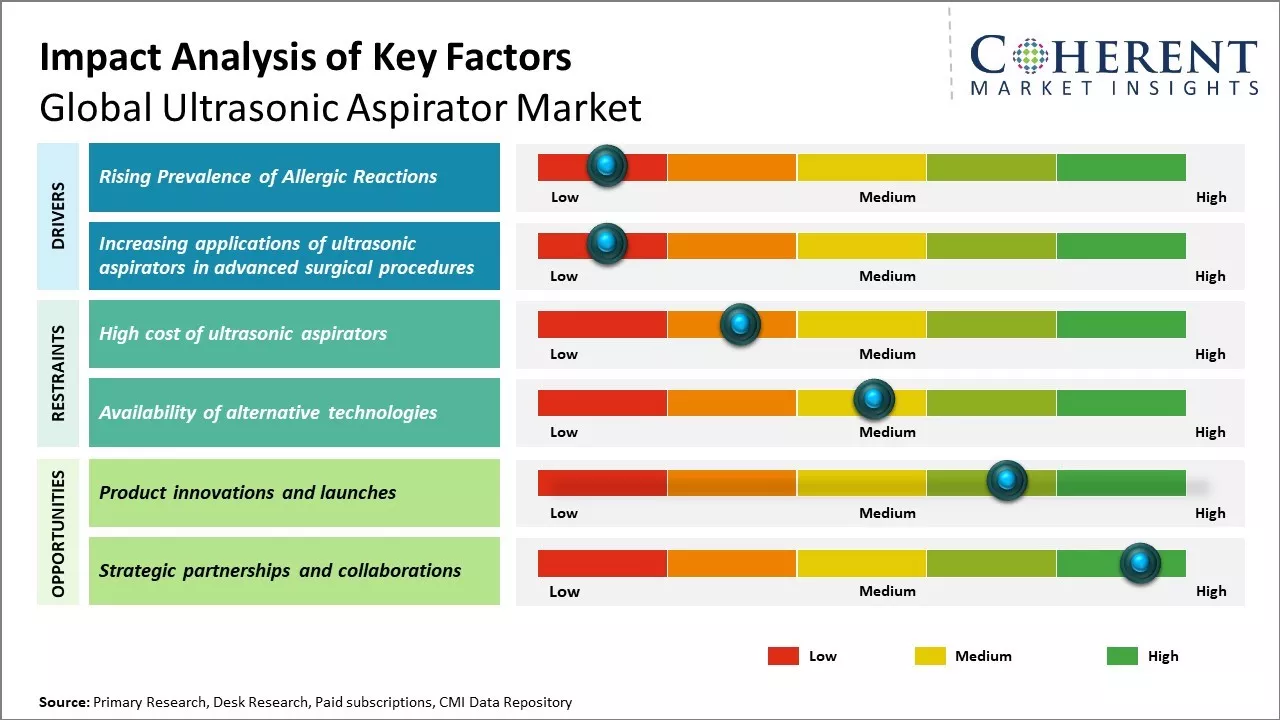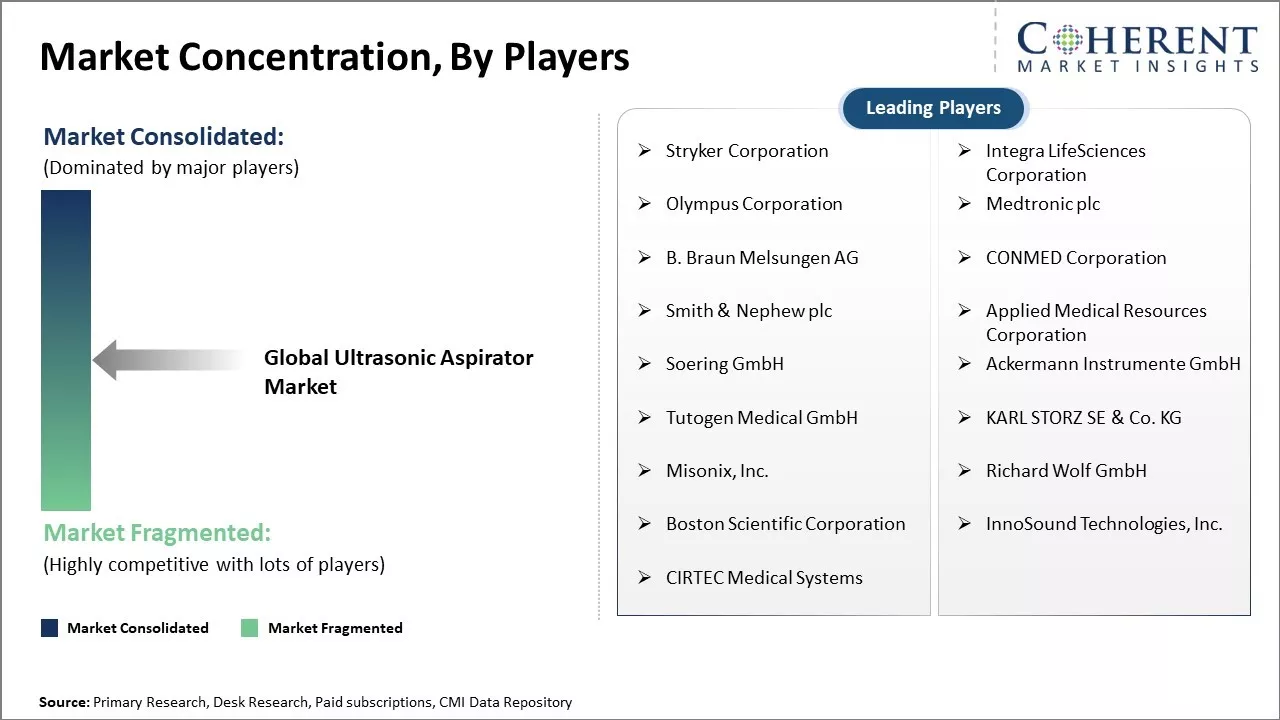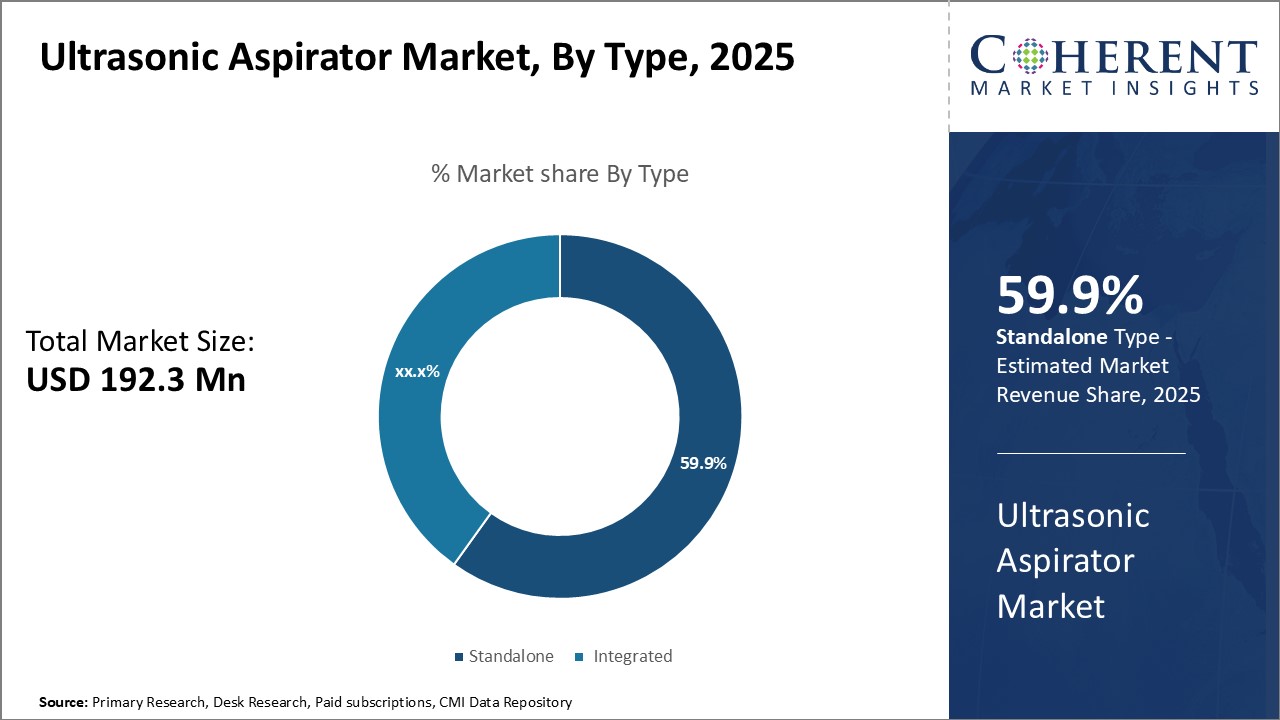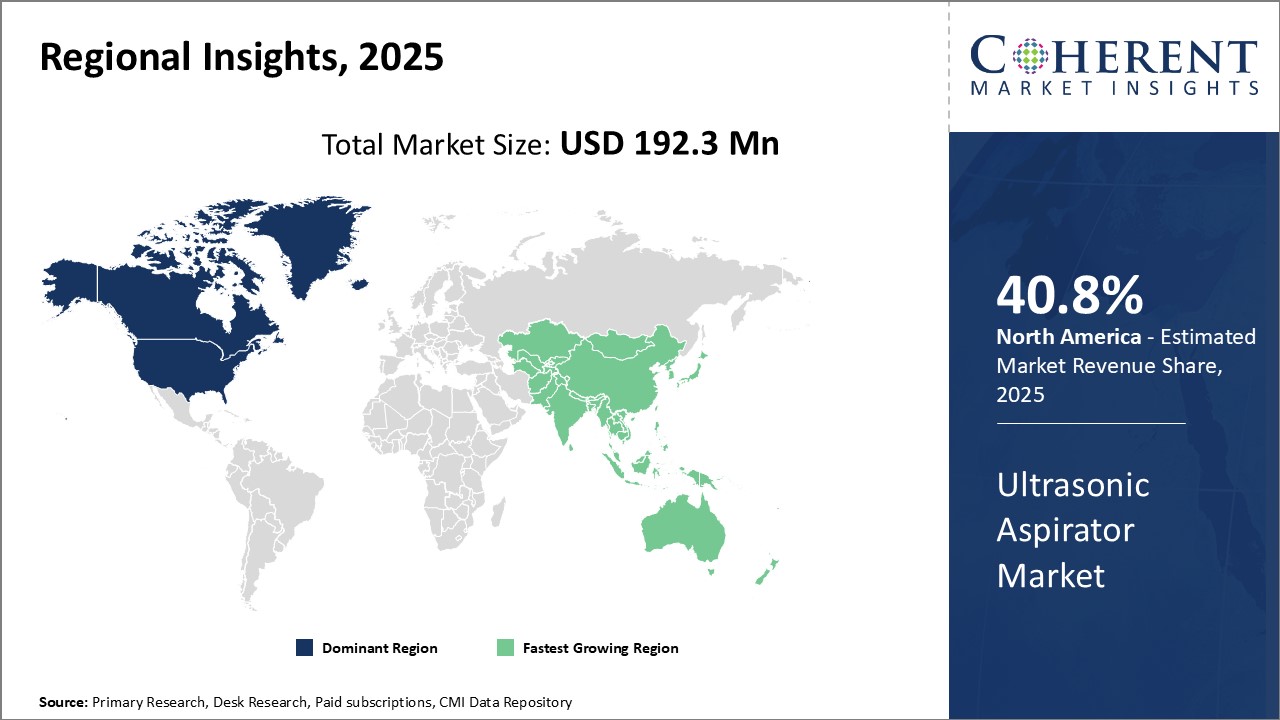Global ultrasonic aspirator market is estimated to be valued at USD 192.3 Mn in 2025 and is expected to reach USD 303.0 Mn by 2032, exhibiting a compound annual growth rate (CAGR) of 6.7% from 2025 to 2032.

Discover market dynamics shaping the industry: Download Free Sample
Global ultrasonic aspirator market growth is driven by rising number of neurological and cancer related surgeries across the globe. Ultrasonic aspirator helps surgeons to dissect blood vessels, nerves and soft tissues accurately during surgeries with low risk of thermal damage, thus, ensuring better clinical outcomes. Growing geriatric population who are more prone to neurological diseases and cancers, increasing awareness about effective surgical procedures and technological advancements in the field of ultrasonic aspirators can boost demand for ultrasonic aspirators. With rising healthcare expenditures and medical tourism in developing regions, the ultrasonic aspirator market can witness growth during forecast period.
Rising demand for minimally invasive surgical procedures
Global ultrasonic aspirator market is expected to witness significant growth over the forecast period due to rising demand for minimally invasive surgical procedures from both patients and surgeons across the world. There has been a shift towards minimally invasive surgeries as it offers benefits like reduced pain, fewer complications, shorter hospital stays, and quicker recovery times for the patients. More and more complex surgeries are now being performed using minimally invasive techniques with the help of advanced instruments and technologies. Ultrasonic aspirators are widely used in minimally invasive neurosurgeries and certain types of ENT procedures as these allow precise removal of tissues with safety. The small size and advanced features of ultrasonic aspirators enable surgeons to carry out complex tasks in hard-to-reach areas of the body through small incisions. This facilitates performing surgeries like tumor removal with minimal damage to surrounding delicate tissues and nerves. Both surgeons and patients prefer minimally invasive approaches as it causes less stress on the body during surgical procedures. Growing obese population globally has also boosted demand for bariatric surgeries, which are mostly carried using minimally invasive methods along with ultrasonic aspirators.

Get actionable strategies to beat competition: Download Free Sample
Increasing applications of ultrasonic aspirators in advanced surgical procedures
Global ultrasonic aspirator market growth is driven by expanding applications beyond traditional neurosurgeries and ENT procedures. Initially used for tissue cauterization and removal in these fields, ultrasonic aspirators are now increasingly employed in challenging surgeries such as vascular and tumor removals, where precision is crucial and bleeding control is vital. Their capability for accurate cutting and coagulation makes them suitable for advanced oncology, urology, orthopedic, and thoracic procedures. Rising cancer cases has further boosted their adoption for precise tumor dissection near sensitive areas like nerves and blood vessels, delivering targeted heat to cancer cells while minimizing collateral thermal damage. Ongoing technological advancements are continually unveiling new applications across diverse therapeutic domains, further enhancing their utility and efficacy in complex surgical settings.
Key Takeaways from Analyst:
Global ultrasonic aspirator market growth is driven by rising preference for minimally invasive surgeries among patients and surgeons. Rising demand for surgical precision and reduced recovery time offered by ultrasonic aspirators can drive the market growth. North America dominates the market due to presence of advanced healthcare infrastructure and favorable reimbursement policies for surgical procedures in the region. Asia Pacific is expected to be the fastest growing regional market led by China and India due to increasing healthcare spending and large patient pool.
Physician familiarity with traditional suction devices and high capital investment required for ultrasonic aspirators can hamper the market growth. However, technological advancements focused on portability, efficiency and ease-of-use of these devices can address such restraints. Market players should focus on emerging Asian countries for future opportunities considering rising medical tourism in these nations. Manufacturers must also consider collaborating with hospitals to educate surgeons about advantages of ultrasonic aspirators over conventional suction devices to expand market reach. Global ultrasonic aspirator market growth is driven by benefits over conventional practices along with supportive regional dynamics and technological improvements.
Market Challenges: High cost of ultrasonic aspirators
The high cost of ultrasonic aspirators can hamper the global ultrasonic aspirator market growth. Ultrasonic aspirators are specialized medical devices that are used for precision tissue cutting and removal during complex surgeries. These devices are expensive, which limits their adoption, especially in developing nations and low resource healthcare settings. Ultrasonic aspirators utilize advanced ultrasonic technology which allows for precise dissection and removal of tissues with minimal damage to surrounding healthy tissues. However, manufacturing such sophisticated electromechanical surgical tools requires significant investments in R&D, high-quality raw materials and components, and specialized manufacturing infrastructure. For instance, a basic ultrasonic aspirator costs around US$ 15,000 and can go up to US$ 50,000-US$ 70,000 for more advanced console models with additional features.
Regular maintenance, repair and software upgrades further add to the lifetime cost of ownership. The high acquisition cost of ultrasonic aspirators poses significant budgetary challenges for many public and private healthcare facilities globally, especially in developing countries. As per data from WHO, in 2021, around 2 billion people globally still lack access to basic surgical care due to resource constraints within their health systems. The upfront capital requirement of purchasing ultrasonic aspirators discourage many cash-strapped hospitals and clinics to invest in these devices, limiting surgical capabilities. This is a major concern in low and middle-income countries where out-of-pocket expenses for patients are already very high. Unless appropriate financing models are developed to make these life-saving tools more affordable, the high device cost will hamper the ultrasonic aspirator market growth.
Market Opportunities: Product innovations and launches
As surgical procedures become more minimally invasive, there is ample opportunity for ultrasonic aspirator manufacturers to launch new devices with enhanced features for improved efficacy and precision. For example, technologies like 3D visualization could allow for real-time monitoring of tissue removal areas without disrupting the surgical site. Similarly, products offering adjustable aspiration levels and variable frequency settings enable customization for different tissue types and procedures. Such personalized capabilities cater to rising demand for customized treatment plans. This customer-centric approach to product development focusing on key adds like precision, accuracy and real-time feedback ensures better clinical outcomes.
Robotic and digitalization trends impacts other surgical tools offer immense potential if applied to ultrasonic aspirators. For instance, devices integrated with augmented reality could project tissue images directly onto surgical glasses for an immersive experience. Similarly, combining robotics with ultrasonic aspiration allows for tighter accuracy and minimizes human errors. This makes surgeries more accessible. As per the data from the World Health Organization, over 18 million new cancer cases and 9.6 million cancer deaths occurred in 2018 alone worldwide. With rising cancer prevalence projected to continue straining healthcare budgets, innovative ultrasonic aspirators enabling less invasive procedures and shorter recovery times address a pressing global unmet need.

Discover high revenue pocket segments and roadmap to it: Download Free Sample
By Type - Convenience and Cost-Effectiveness Boosts Demand for Standalone Ultrasonic Aspirators
In terms of type, standalone segment is estimated to contribute the highest market share of 59.9% in 2025, owing to its convenience and lower costs as compared to integrated ultrasonic aspirators. Standalone aspirators are portable, self-contained devices that do not require integration with additional surgical tools or equipment. Their portability and plug-and-play functionality allow clinicians to use them more flexibly in a variety of procedures and settings. This convenience translates to time savings in surgical preparation and turnaround between cases. As standalone units, these also eliminate integration costs and complexity associated with ensuring proper function of interconnected medical devices.
The self-contained nature of standalone aspirators makes them well-suited for minor outpatient procedures conducted in clinics as well as emergency settings. Their ease of use and transportability facilitate faster procedure times, which is important for efficient clinic workflows. This has increased their adoption in ambulatory surgical centers and clinics in addition to hospitals. The lower price point of standalone aspirators as compared to integrated units also expands their accessibility in cost-sensitive healthcare markets. Their affordability leads to broader application across a wider range of general surgical and trauma-related cases.
By Application - Neurosurgery Dominates Due to Delicate Nature of Procedures
In terms of application, neurosurgery segment is estimated to contribute the highest market share of 30.5% in 2025, owing to the precision and care required for brain and spinal surgeries. Ultrasonic aspirators are invaluable tools for neurosurgical procedures due to their highly precise cauterizing and tissue-removal capabilities. Their differentiated ultrasonic technology allows for superior control and minimal thermal damage during delicate operations near sensitive structures like blood vessels and nerves. This makes them preferable over electrosurgical devices for tasks like tumor resection in the brain, where even minor thermal injury could have severe consequences. Precise removal and hemorrhage control is especially critical considering the Brain’s limited capacity for tissue regeneration.
The small diameter tips and adjustable power levels of ultrasonic aspirators enable maximum visualization and protect non-target tissues. Their ability to coagulate blood vessels up to 5mm in diameter is important for preventing hemorrhaging during surgery. Given the complexity and risks associated with neurosurgeries, clinicians rely heavily on ultrasonic aspirators to improve safety, efficacy and procedural outcomes for patients. This boosts their widespread adoption across hospitals with dedicated neurosurgery departments and trauma centers.
By End User - Preference for Hospitals Arises from Complex Case Loads and infrastructure
In terms of end user, hospitals segment is estimated to contribute the highest market share of 60.5% in 2025, due to greater infrastructure and higher caseloads including complex procedures. As full-service medical facilities, hospitals commonly manage a higher volume and variety of surgical cases compared to clinics or ambulatory centers. These include highly complicated and lengthy procedures involving major organs, which carry greater risks. Hospitals prefer reliable medical devices with versatile functionalities like ultrasonic aspirators. Relative to other end users, hospitals also have larger budgets that facilitate investment in premium technologies to support a wide spectrum of cases. Their staffing of specialized surgeons boosts demand for advanced tools like ultrasonic surgical aspirators.
Hospitals additionally possess extensive on-site support infrastructure for heavy-duty capital equipment. This includes dedicated biomedical engineering teams for comprehensive services like equipment service agreements, repair and training. Access to such resources instills confidence among hospital administrators and clinicians when investing in precision-oriented devices. These factors cement hospitals’ position as the largest procurers of high-end ultrasonic aspirators compared to other end users.

Need a Different Region or Segment? Download Free Sample
North America dominates the global ultrasonic aspirator market with an estimated market share of 40.8% in 2025. The region accounts for around one-third of the global market share, owing to a well-established healthcare infrastructure and higher expenditure on healthcare. The presence of global market leaders from medical technology has ensured continued supply of advanced ultrasonic aspirator devices in the region. The U.S. contributes over 80.5% of the North American ultrasonic aspirator market due to the large patient population and growing number of niche clinics offering specialized surgeries. Moreover reimbursement scenarios for surgical procedures in the country promote the adoption of high-end medical devices. Leading manufacturers also focus on the U.S. market first while launching new products due to better pricing flexibility and acceptance of new technologies among clinicians.
The Asia Pacific region has emerged as the fastest growing regional market for ultrasonic aspirators, majorly contributed by China and India. Rapid economic expansion, growing private healthcare sectors and increased focus of global companies to tap opportunities drives the market growth. China dominates the overall APAC ultrasonic aspirator market due to its large population size and increased healthcare spending. Booming medical tourism industry has enhanced the availability of advanced surgical treatments. Indian market has exhibited most impressive growth trends due to government initiatives for strengthening public healthcare systems. Local manufacturers are also striving to provide affordable options to expand the consumer base.
Ultrasonic Aspirator Market Report Coverage
| Report Coverage | Details | ||
|---|---|---|---|
| Base Year: | 2024 | Market Size in 2025: | USD 192.3 Mn |
| Historical Data for: | 2020 To 2024 | Forecast Period: | 2025 To 2032 |
| Forecast Period 2025 to 2032 CAGR: | 6.7% | 2032 Value Projection: | USD 303.0 Mn |
| Geographies covered: |
|
||
| Segments covered: |
|
||
| Companies covered: |
Thermo Fisher Scientific Inc., Stryker Corporation, Integra LifeSciences Corporation, Olympus Corporation, Medtronic plc, B. Braun Melsungen AG, CONMED Corporation, Smith & Nephew plc, Applied Medical Resources Corporation, Soering GmbH, Ackermann Instrumente GmbH, Tutogen Medical GmbH, KARL STORZ SE & Co. KG, Misonix, Inc., Richard Wolf GmbH, Boston Scientific Corporation, InnoSound Technologies, Inc., CIRTEC Medical Systems |
||
| Growth Drivers: |
|
||
| Restraints & Challenges: |
|
||
Uncover macros and micros vetted on 75+ parameters: Get instant access to report
*Definition: Global ultrasonic aspirator market consists of devices that use ultrasonic energy in the form of high-frequency sound waves to remove fluids, blood clots, and tissue fragments during surgery. Ultrasonic aspirators allow for precise cutting and simultaneously evacuation of debris and fluids from the surgical site, helping surgeons obtain unobstructed field of view. These offer benefits like minimal thermal injury, increased precision and control during procedures. The market has seen significant growth in recent years due to increasing surgery volumes worldwide and advancements in ultrasonic technology for minimally-invasive procedures.
Share
Share
About Author
Manisha Vibhute is a consultant with over 5 years of experience in market research and consulting. With a strong understanding of market dynamics, Manisha assists clients in developing effective market access strategies. She helps medical device companies navigate pricing, reimbursement, and regulatory pathways to ensure successful product launches.
Missing comfort of reading report in your local language? Find your preferred language :
Transform your Strategy with Exclusive Trending Reports :
Frequently Asked Questions
Joining thousands of companies around the world committed to making the Excellent Business Solutions.
View All Our Clients